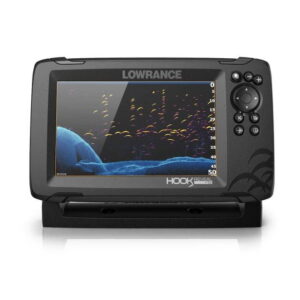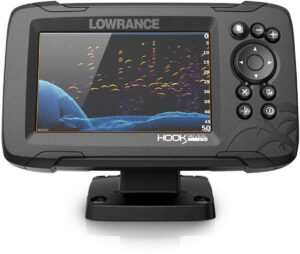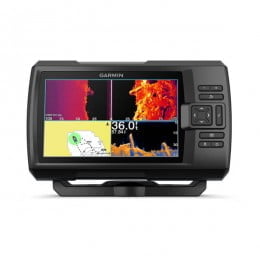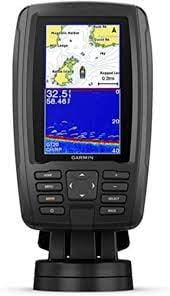Want record-breaking catches without breaking the bank? You’re in the right place.
We’ve compiled a list of the best fish finders you can get for under $500.
These fish finders are powerful, feature-rich, and versatile - they can be used by casual anglers and enthusiasts alike. They offer excellent displays, great sonar, and more.
Once you’ve taken a look at our picks for the best fish finders, you can scroll down to learn about the criteria we used to find our top picks - sonar and imaging; mapping and charting; display and screen; and interface.
Before that, though, we’re excited to reveal our top picks. You’ll find fish finders by a number of different manufacturers, fish finders of different sizes, and fish finders that are perfect for various styles of fishing. So, without further ado, let’s take a look at our favorite budget fish finders of 2022:
| Lowrance HOOK Reveal 7 | Lowrance HOOK Reveal 5 | Humminbird HELIX 5 | Garmin Striker Vivid 7 | Garmin ECHOMAP Plus 44cv |
|---|---|---|---|---|
 |
 |
 |
 |
 |
| Frequency: CHIRP 200 kHz; DownScan/SideScan 455/800 kHz | Frequency: CHIRP 200 kHz DownScan 455/800 kHz | Frequency: Medium and High CHIRP 75/155 kHz + 130/250 kHz | Frequency: 50/77/200 kHz, CHIRP 83/200 kHz, ClearVu/SideVu 260/455/800 kHz | Frequency: Traditional 77/200 ClearVü CHIRP 455 kHz and 800 kHz |
| Screen Size: 7" | Screen Size: N/A | Screen Size: 5 inch | Screen Size: 7” | Screen Size: 4.3-inch |
| Resolution: 800 x 480 SolarMax | Resolution: N/A | Resolution: 800x480 | Resolution: 800x480 | Resolution: N/A |
| Imaging: 150 ft. - 300 ft. down; 100 ft. per side (800 kHz)/ 300 ft. per side (455 kHz) | Imaging: 150 ft. down (800 kHz)/300 ft. down (455 kHz)* | Imaging: 350 ft. Down, 250 ft. Side | Imaging: ClearVu 500 ft, SideVu 500 ft (250 ft per side)* | Imaging: N/A |
| GPS: Internal, High-Precision | GPS: Internal, High Precision | GPS: Internal, High Precision | GPS: Internal, high precision | GPS: Internal, High Precision |
| Maps Included: None OR 4000 US Lakes OR C-Map Contour+ | Maps Included: None OR 4000 US Lakes or C-MAP Contour+ | Maps Included: Humminbird Basemap | Maps Included: N/A | Maps Included: Bluechart 3 |
| Max Waypoints: 3000 (100 routes/100 tracks) | Max Waypoints: 3000 Waypoints 100 Routes 100 Trails | Max Waypoints: 2500 | Max Waypoints: 5,000, 100, 50 (50 000) | Max Waypoints: 5000 |
| Memory Card Slots: Micro SD | Memory Card Slots: 1 Micro SD slot (32 GB max) | Memory Card Slots: Micro SD | Memory Card Slots: N/A | Memory Card Slots: Micro SD |
| Transducer: DownScan | Transducer: SplitShot | Transducer: XNT 9 SI 180 T | Transducer: GT52HW-TM* | Transducer: GT20-TM |
| Screen: N/A | Screen: 5”, 800 x 480, HD, backlit, SolarMAX screen | Screen: N/A | Screen: HD, backlit | Screen: N/A |
| Best Price (Amazon) Best Price (Bass Pro) Best Price (Amazon) Best Price (Bass Pro) Best Price (Amazon) Best Price (Bass Pro) | Best Price (Amazon) Best Price (Bass Pro) | Best Price (Amazon) Best Price (Bass Pro) | Best Price (Amazon) Best Price (Bass Pro) | Best Price (Amazon) Best Price (Bass Pro) |
The Hook Reveal 7 is a fish finder with enhanced sonar capabilities, mapping options, and easy-to-use features. The unit has a simple layout but has become a reliable piece of tech for anglers looking to stay on budget. Its affordable price point means that there are sacrifices that Lowrance had to make, such as the networking options. However, where the unit lacks in networking, it makes up for in transducer options.
There are three transducer choices: SlipShot, TripleShot, and 50/200 HDI. Some customers may be confused between the three options. They each have their own benefits, but the SplitShot is the least expensive. All three transducers offer CHIRP sonar, which is what you want if you’re looking for accurate readings. At the end of the day, the Hook Reveal 7 is an excellent piece of tech that can provide an angler with the advantages needed when on the water.
Once again, Humminbird has stepped up the technology with this fish finder model. The Helix 5 provides CHIRP sonar, which can scan the depths of the water using multiple frequencies. With advanced sonar, you’ll get better target separation, reduced image noise, and higher-resolution displays that can reach a depth of 1000 feet or more.
If you don’t mind a smaller screen and you want to save some cash, this unit still has a lot to offer. Sonar aside, the GPS allows you to use LakeMaster, which provides satellite imaging to give you an idea of where the best fishing spots are. It’s a useful option because the unit’s storage space may fill up quickly when downloading maps. This is by far one of the best fish finders you can get for under $500.
There are many fish finders out there with obscenely high price tags. The Garmin Striker 7sv isn’t one of them. This unit comes packed with features that improve the overall fishing experience and sonar capabilities that can provide more details. The ClearVü and SideVü technology can produce near-perfect photo-quality images of cover and structures in the water, which can help you find more fish.
One of the more valuable aspects of the Striker 7sv is its flasher function. When the flasher mode is engaged, you can block out any data on the screen that you don’t want and keep the information you need. The 7sv has an easy-to-use intuitive interface, built-in GPS with customizable waypoints, a crisp display screen, and additional features that any angler can appreciate. You can’t go wrong with this unit if you’re looking for an affordable and more than capable fish finder.
Lowrance has done it again. The Hook Reveal 5 is one of the best fish finders under $500 that you can get. The screen is a lot clearer than most budget units on the market. The SolarMax technology allows anglers to fish in all kinds of weather conditions, and while the screen is small, it produces a four-panel split-screen function. The Hook Reveal 5 doesn’t include SideScan, but it does feature DownScan. The DownScan can be quite powerful as you can opt between frequencies for a longer range or clearer imaging.
The Hook Reveal 5 falls short with its lack of networking capabilities but makes up for it with excellent mapping, SplitShot sonar, and more. This model is the perfect unit for beginners or hobbyists working with a smaller budget and who want the impeccable benefits that a fish finder can provide while on the water.
If you’re on a budget, the Garmin Echomap Plus 44cv might be the fish finder for you. This unit comes with a plethora of features and uses that anglers can benefit from. Its LED backlight keeps the screen bright on bright sunny days, the CHIRP and ClearVü sonar capabilities are powered by the GT20 transducer, and it’s pre-installed with Quickdraw Contours mapping software. While the smaller display may take some time to get used to, the Echomap Plus 44cv can show scanned depths of up to 2400 feet in freshwater and 1100 feet in saltwater.
There is just so much to enjoy with this impressive unit. While it may be short on Wi-Fi connectivity and touch screen potential, every angler can find something to like about the model. Whether you’re looking for reliable sonar capacities, chartplotter options, network communication, or a compact unit for an affordable price, you’ll walk away happy with your purchase.

Now that you’ve seen our top picks, let’s take a few moments to discuss how we evaluated the various fish finders available on the market. The price, of course, needed to be $500 or less. The other major factors we considered were sonar and imaging; mapping and charting; display and screen; and interface. Other factors, like aesthetics, were considered but didn’t play a major role in determining our top picks.
Well-informed anglers make the best decisions. By following this guide and learning more about the criteria we used to choose our top picks, you’ll be able to find the perfect fish finder for your needs. There’s a lot of information to cover, so let’s dive in!
Sonar is, quite arguably, the most important factor when choosing a fish finder. Without a great transducer and a wide range of frequencies available, the primary function of your fish finder - that is, finding fish - will be limited. A wide range of frequencies and high-quality sonar will enable you to find fish in shallow and deep water, all while maintaining a clear image with well-defined targets.
Imaging is a more modern feature and one that many anglers find invaluable. The quality of your imaging depends heavily on the quality of your sonar - higher frequencies lead to sharper images but less range and depth.
When thinking about sonar and imaging, consider:
You can find fish finders that offer high-quality sonar and imaging for under $500 - and many of our top picks deliver on that front. Let’s take a brief moment to talk about CHIRP and the two kinds of imaging: Down and side imaging.
Sonar is, quite arguably, the most important factor when choosing a fish finder. Without a great transducer and a wide range of frequencies available, the primary function of your fish finder - that is, finding fish - will be limited. A wide range of frequencies and high-quality sonar will enable you to find fish in shallow and deep water, all while maintaining a clear image with well-defined targets.
Compressed high-intensity radiated pulse (CHIRP) started as military technology - today, it’s the gold standard for fish finder sonar. CHIRP sonar sends a longer pulse than traditional sonar - this pulse also contains varying frequencies.
The end result is better target separation and more accurate readings. Varying frequencies provide more information for your transducer and fish finder to interpret - and more data is always better when it comes to sonar.
Our picks feature fish finders with CHIRP sonar - the cost of the technology has come down so drastically that there’s almost no reason to buy a finder without CHIRP. Remember - increase the frequency for better imaging and shallow water fishing, and decrease it for more range and deep water fishing.
There are two types of imaging - down and side. And unless you’re trying to catch flying fish, that’s all you’re going to need. Don’t expect “up imaging” any time soon.
Down imaging is a relatively new technology, and it takes a transducer capable of very high frequencies to get a high-quality image. That means it costs more to get down imaging - but not so much more that we couldn’t include several finders capable of down imaging in our top picks under $500.
Who needs down imaging? Anyone who wants to improve their scouting. You’ll see clear images of bottom structure and schools of fish with down imaging technology, and those images can help you pick the perfect spot to fish.
Most fish finders and transducers are designed to show you what’s beneath your boat; after all, that’s where you’re going to be fishing. Side imaging is one of the most recent fish-finding innovations. The best side imaging fish finders allow you to view structure up to 800 feet away from your boat - usually about 400 feet per side.
Cutting-edge technology is always more expensive, and most side imaging fish finders fall outside of our maximum $500 price range. We did, however, include some absolutely incredible fish finders that do feature side imaging. These fish finders are perfect if you want to pre-fish a lake before a tournament or if you want to take your scouting game to the next level.
In 1989, the first commercially available GPS, the NAV 1000, was released. It cost a whopping $3000, weighed a whole bunch, had about 2 hours of battery life, and only provided text results - we hope you knew your longitudes and latitudes!
How times have changed! Today, it’s easy to find a fish finder with GPS, maps, and charting technology for under $500. And trust us, you’re not getting text results. These devices can show depth maps featuring 1’ contours at incredible precision.
Not everyone needs chartplotting functionality - especially if you already have a chartplotter/fish finder combo on your vessel. For those without a chartplotting device, however, we highly recommend getting one - many of our top picks under $500 come with high-quality maps, charting, and GPS.
Why are mapping and charting important? They make fishing easier. You’ll get a variety of features with your maps, from depth contours to shallow water and depth shading. You’ll be able to chart a course before you even head out on the water, mark your favorite fishing spots, and more.
The three top fish finder brands (Garmin, Humminbird, and Lowrance) all offer fish finders with maps and charting. If you’re new to fish finders, it can be hard to know which maps offer what functions. Let’s clear things up:
Garmin offers three types of maps through Navionics: The Worldwide Basemap, BlueChart, and LakeVü.
The Worldwide Basemap offers basic coverage of large lakes, coastal waters, and land masses. BlueChart offers coastal coverage, including auto-routing based on your boat’s draft and overhead height and color-coding of water depth based on your boat’s draft. LakeVü offers many of the same features as BlueChart, but for lakes instead of coasts - additionally, LakeVü offers maps for some smaller inland lakes.
The Worldwide Basemap comes standard for most Garmin chartplotters, but you can purchase a variety of BlueChart and LakeVü maps - sometimes, they’ll even come bundled with your fish finder for under $500. If you buy a BlueChart or LakeVü map, you can upload it to your fish finder with ActiveCaptain (as long as your fish finder is compatible with ActiveCaptain).
Humminbird follows most of the same conventions that Garmin does. The Basemap offers coverage of many large inland lakes but without a lot of detail. LakeMaster provides depth shading and auto-routing, while LakeMaster+ also offers aerial satellite photos as an overlay. BlueChart offers high-quality coastal coverage, including auto-routing and depth shading.
Lowrance offers maps through C-Map. When it comes to C-Map, you’re not starved for options - There are Max-N+, Discover, and Reveal maps, all of which come with their own advantages and features.
There are literally too many features on these maps to cover succinctly here, and C-Map compatibility is one of the biggest pros of Lowrance fish finders. We encourage you to check out the C-Map website to learn more.
Size matters when it comes to fish finders - but bigger doesn’t always mean better. By opting to select fish finders with smaller screens, we were able to fill our top picks under $500 with feature-rich fish finders.
There are two major considerations when evaluating a display: The size of the screen and its resolution. Resolution is extremely important when it comes to great target separation and overall accuracy, so we value it very highly.
Smaller screens are great for smaller vessels - they’re also great for saving money, which is why our top picks all have screens of 7” or less. There is, however, a cost - larger screens are better if you’ve got the space and money for them.
Most high-end modern fish finders offer imaging and sonar. They also offer split-screen views so that you can look at your imaging and traditional sonar chart simultaneously. The larger your screen is, the better these split views work - if you plan on using maps and sonar simultaneously, we recommend at least a 5” screen, with a 7” screen being even better if you’re willing to spend about $500.
Almost all of the fish finders in our top picks under $500 offer HD resolution. Target separation, clear arches, and easy-to-read structure are essential. Unless you’re ice fishing or you want a very low-cost option, it’s well worth it to pay a little more for high resolution.
Here’s a quick rule we kept in mind when evaluating the interfaces of our picks: The smaller the screen, the worse touchscreen controls become.
We highly value hybrid controls - in most cases, that’s a touchscreen and a keypad interface. Touchscreens are the fastest way to interact with a fish finder, but when they get wet, they can become impossible to use. Keypads decrease the biggest weakness of touchscreens.
In terms of layout and design, there are pros and cons to each of these fish finders. As a rule of thumb, the more feature-rich ones are more difficult to navigate - but as you learn which features you like the most and add views to your home screen, the interface becomes easier to use. Take your fish finder for a dry run before you take it out on the water to get a feel for the interface!
When you’re shopping for a fish finder under $500, some level of compromise needs to be made - and we’ve opted to make that compromise on screen size in most cases.
Why? Because the size of your screen is only relevant when you have a lot of features. The fish finders we’ve chosen have great sonar, tons of useful features, and great resolution. Many even come with maps and charting.
No two anglers have exactly the same preferences, so we highly encourage that you consider what matters most to you when shopping for a fish finder. Many of our picks offer incredible bang for your buck and can be used by even the most particular enthusiasts. We’re sure that you’ll find the perfect fish finder for your needs among them.
Thanks for reading, and happy fishing!